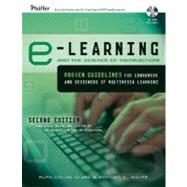
Note: Supplemental materials are not guaranteed with Rental or Used book purchases.
Purchase Benefits
What is included with this book?
Ruth Colvin Clark has worked for more than twenty-five years with instructional professionals assigned to design, develop, and select effective training for classroom or computer delivery. She is widely published in the areas of training, development, and performance improvement.
Richard E. Mayer is professor of psychology at the University of California, Santa Barbara. He is an internationally-recognized expert in the application of learning psychology to design of instruction in multimedia learning environments and the author of Multimedia Learning and is the editor of the Cambridge Handbook of Multimedia Learning.
| Acknowledgments | |
| Preface | |
| Introduction | |
| e-Learning: Promise and Pitfalls | |
| The e-Learning Bandwagon | |
| What Is e-Learning? | |
| Self-Study vs | |
| Virtual Classroom e-Learning | |
| e-Learning Development Process | |
| Two Types of e-Learning Goals: Inform and Perform | |
| Is e-Learning Better? Media Comparison Research | |
| What Makes e-Learning Unique?e-Learning: The Pitfalls | |
| What Is Good e-Courseware?Learning in e-Learning | |
| How Do People Learn from e-Courses | |
| How Do People Learn? | |
| How Do e-Lessons Affect Human Learning? | |
| What Is Good Research? | |
| How Can You Identify Relevant Research? | |
| How Do You Interpret Research Statistics? | |
| What We Don't Know About Learning | |
| Applying the Multimedia Principle: Use Words and Graphics, Rather Than Words Alone | |
| Do Visuals Make a Difference? | |
| Multimedia Principle: Include Both Words and Graphics | |
| Some Ways to Use Graphics to Promote Learning | |
| Psychological Reasons for the Multimedia Principle | |
| Evidence for Using Words and Pictures | |
| The Multimedia Principle Works Best for Novices | |
| Should You Change Static Illustrations into Animations? | |
| What We Don't Know About Visuals | |
| Applying the Contiguity Principle: Align Words to Corresponding Graphics | |
| Contiguity Principle | |
| Place Printed Words Near Corresponding Graphics | |
| Contiguity Principle | |
| Synchronize Spoken Words with Corresponding Graphics | |
| Psychological Reasons for the Contiguity Principle | |
| Evidence for Presenting Printed Words Near Corresponding Graphics | |
| Evidence for Presenting Spoken Words at the Same Time as Corresponding Graphics | |
| What We Don't Know About Contingency | |
| Applying the Modality Principle: Present Words as Audio Narration, Rather Than On-Screen Text | |
| Modality Principle: Present Words as Speech Rather Than On-Screen Text | |
| Limitations to the Modality Principle | |
| Psychological Reasons for the Modality Principle | |
| Evidence for Using Spoken Rather Than Printed Text | |
| When the Modality Principle Applies | |
| What We Don't Know About Modality | |
| Applying the Redundancy Principle: Explain Visuals with Words in Audio or Text: Not Both | |
| Redundancy Principle | |
| Do Not Add On-Screen Text to Narrated Graphics | |
| Psychological Reasons for the Redundancy Principle | |
| Evidence for Omitting Redundant On-Screen Text | |
| Redundancy Principle | |
| Consider Adding On-Screen Text to Narration in Special Situations | |
| Psychological Reasons for Exceptions to Redundancy Principle | |
| Evidence for Including Redundant On-Screen Text | |
| What We Don't Know About Redundancy | |
| Applying the Coherence Principle: Adding Interesting Material Can Hurt Learning | |
| Coherence Principle | |
| Avoid e-Lessons with Extraneous Audio | |
| Psychological Reasons to Avoid Extraneous Audio in e-Learning | |
| Evidence for Omitting Extraneous Audio | |
| Coherence Principle | |
| Avoid e-Lessons with Extraneous Graphics | |
| Psychological Reasons to Avoid Extraneous Graphics in e-Learning | |
| Evidence for Omitting Extraneous Graphics | |
| Coherence Principle | |
| Avoid e-Lessons with Extraneous Words | |
| Psychological Reasons to Avoid Extraneous Words in e-Learning | |
| Evidence for Omitting Extraneous Words Added for Interest | |
| Evidence for Omitting Extraneous Words Added to Expand on Key Ideas | |
| Evidence for Omitting Extraneous Words Added for Technical Depth | |
| What We Don't Know About Coherence | |
| Applying the Personalization Principle: Use Conversational Style and Virtual Coaches | |
| Personalization Principle | |
| Use Conversational Style Rather Than Formal Style | |
| Psychological Reasons for the Personalization Principle | |
| Evidence for Using Conversational Style | |
| Promote Personalization Through Voice Quality | |
| Promote Personalization Through Polite Speech | |
| Personalization Principle | |
| Use Effective On-Screen Coaches to Promote | |
| Table of Contents provided by Publisher. All Rights Reserved. |
The New copy of this book will include any supplemental materials advertised. Please check the title of the book to determine if it should include any access cards, study guides, lab manuals, CDs, etc.
The Used, Rental and eBook copies of this book are not guaranteed to include any supplemental materials. Typically, only the book itself is included. This is true even if the title states it includes any access cards, study guides, lab manuals, CDs, etc.